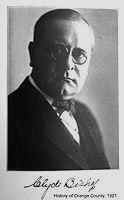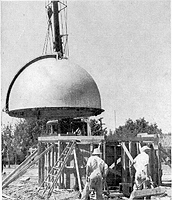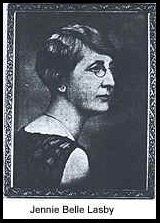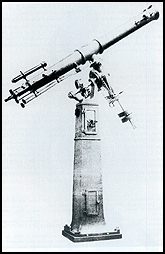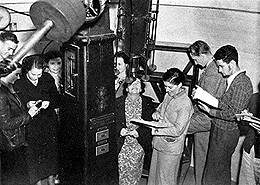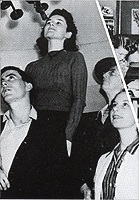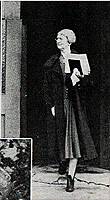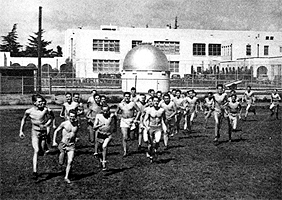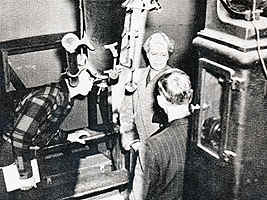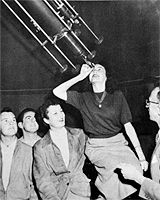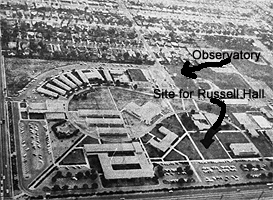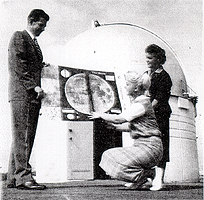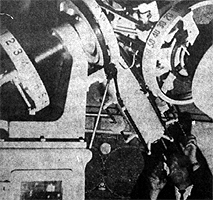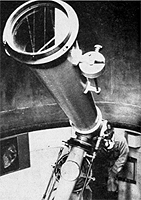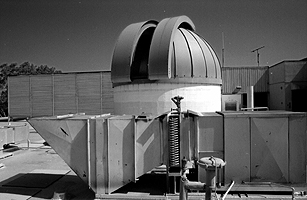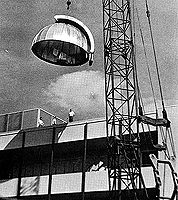The Bishop Observatory – some history
Posted On December 27, 2002
Mr. Bishop's Telescope 1923 - 1930
The 8" Alvan Clark refractor of the Bishop Observatory inspired and instructed students of Santa Ana College (SAC) for more than three generations. The college is located in the city of Santa Ana, the county seat of Orange County, immediately south of Los Angeles. Although the telescope has been in the possession of the college for over half a century, it was originally owned by amateur astronomer Clyde Bishop who built an observatory for it at his home in Lemon Heights (above photo). Mr. Bishop (1875 - 1927) was a well known Orange County attorney in the early years of the twentieth century and was very active in civic affairs. His biography, given in The History of Orange County (1921)1 , speaks of a solid citizen, the head of a successful law firm, twice elected to public office on the Republican ticket (state assemblyman), and, for a time, city attorney for the city of Orange. Despite these solidly conservative credentials, the early part of his life appears to have been rather adventurous. At the age of twenty he left the family farm outside Orange and joined a traveling theater company as an actor. Exactly how long he pursued this profession is not known, but long enough to tour and perform on both coasts and south into Mississippi. His theatrical career came to an end when he was stirred by the call to arms at the onset of the Spanish - American war and volunteered for the army. He saw no action, however, serving out his enlistment at the Presidio in San Francisco.
TheAfter leaving the army, he returned to Orange County where he studied law as an apprentice at the law firm of McKelvey and Montgomery in Santa Ana. By 1902 he had established his own law office and began his rise as a "pillar of the community". Exactly when he acquired an interest in astronomy is not known, but he clearly was in contact with Jennie Lasby (later Tessmann) almost as soon as she began her teaching career at Santa Ana Junior College in 1919. This can be surmised from the fact that Ms. Lasby is known to have served as Bishop's "technical advisor" in the selection of the telescope and in the construction of the observatory which was initiated shortly after her arrival in Orange County2.
I think that the case can be made that Jennie Lasby was the major influence in Bishop's acquiring the telescope and equipping the observatory. Ms. Lasby was a first rate professional astronomer, in the first group of women hired by George Ellery Hale to work at Mt. Wilson, and co-author with future observatory director Walter Adams of a pioneering work on solar spectroscopy 3 . She was subsequently offered positions with J. C. Kapteyn in Germany (thwarted by World War I) and at the University of Chicago, but she chose to move to Santa Ana to be near her ailing parents. Ms. Lasby received her undergraduate degree from Carleton College in Minnesota and her master's degree from Mt. Holyoke College in Massachusetts. She worked in the observatories of both of these institutions (Goodsell at Carleton and Williston at Mt. Holyoke), and they both had 8" Alvan Clark refractors 4 . It would appear that Mr. Bishop was advised to install a modern (1920s) version of these academic observatories at his home. The earlier telescopes were research grade instruments, equipped with spectroscopes, camera attachments and Herschel wedges for solar observing. The Bishop observatory's 8" refractor had all of these accessories, making it the equal of the institutional instruments. Ms. Lasby makes it clear in several articles published in the 1930s that she expected to do serious work with the Bishop telescope. I have been unable to locate the original spectroscope or the camera attachment, but the Herschel wedge is still in the eyepiece box.
According to Mabel Sterns' Directory of Astronomical Observatories in the United States5, the observatory was built in 1923, a "Concrete building with a motor-driven steel dome". The 1923 date may refer to the telescope's manufacture (see below), since real estate records indicate that the house itself was not occupied until sometime in 1926. The estate was clearly something of a showpiece in the mostly rural Orange County of the 1920s, as evidenced by a featured pictorial in the real estate section of the Santa Ana Register dated November 18, 1926 (Lemon Heights Residences Rank Among the Southland's Most Attractive)6. A concrete pier firmly anchored in the ground was provided to support the mounting. This pier was isolated from the structure of the house to insure that vibrations were not transmitted to the telescope. Although the observatory was moved from Lemon Heights in 1940, as late as 1999 a portion of the pier still remained intact at the Bishop estate7 (the house has since been completely renovated and the remaining section of the pier removed).
I have not been able to locate a period photograph which gives an overview of the completed telescope on its mounting. However, I can attest that when it was operational in the1980s it looked virtually identical to the accompanying illustration which is from the authoritative Alvan Clark & Sons, Artists in Optics by Deborah Jean Warner and Robert B. Ariail. The distinctive feature of the telescope is the mounting which the company called the "Universal Observatory Mount, Type B". Warner and Ariail state that this mount was very rare and only a handful were ever built. Its distinguishing feature is the horseshoe shaped casting which supports the polar axis and is large enough to hold a right ascension setting circle of considerable diameter. The clock drive was electrically driven with a governor to regulate the speed. Overall, the mounting is very similar to a design offered a few years later by Warner and Swasey. The telescope was equipped with three eyepieces, along with the previously mentioned spectroscope, camera attachment and Herschel wedge.
The 8" objective lens is an achromatic f/15 doublet and is identical to the one prepared for Manuel Grno de Castresano of Arequipa, Peru. The technical details for the Arequipa lens are given on page 259 of the notebook in which Robert Lundin (the Clark corporation's chief optician) kept a record of every Alvan Clark objective made from 1882 to 1927. At the bottom of this page is the notation: "C. Bishop's same glass and curves as above". The page is dated January 7, 1924, implying that the actual fabrication of the Arequipa objective was in 1923. Since the Bishop notation was clearly added later, the fabrication date for the Bishop lens is less certain, although the lack of a separate entry implies that it was made at about the same time. It appears that the glass blanks were from a new vendor, since there is a brief notation on the page margins which states "The material is entirely different from any I have record of ". The data in the notebook suggest that the unknown characteristics of the glass led to an error in the original curvature, and the lens had to be reground to achieve the desired color correction and focal length. Since the Arequipa lens was ground and polished first, there would have been no need for a similar learning curve with the Bishop objective.
The date of 1923 is significant in accessing the optical quality of the objective lens. Alvan Clark and his sons, George and Alvan Graham, were the premier American telescope makers of the late 19th century, probably the finest in the world, and builders of the two largest refractors ever made, the 36" at Lick and the 40" at Yerkes. The definitive history of this telescope making family and their company is given by Warner and Ariail (op. cit.). All of the Clarks were dead by the turn of the twentieth century, but the master optician C. A. R Lundin who had been hired by Alvan Clark in 1874 remained to carry on the tradition of fine optical craftsmanship. Lundin's son Robert, a skilled optician trained by his father, was in charge of the company's optical department in the 1920s. However, by the 1930s the company was in decline. Lundin had left, and the historic grinding tools and other equipment were disposed of in an early World War II scrap metal drive. The fact that the Bishop telescope dates from 1923 means that the lens might well have been polished and figured by Robert Lundin himself who, among other things, polished and figured the 13 inch camera lens for Lowell Observatory with which Clyde Tombaugh discovered Pluto10.
Exactly what use was made of the telescope in the early years is not known. It was definitely involved in variable star work by 1929, but there is no evidence that it was used for this purpose in the first few years of its operation. There is an article in a 1941 issue of El Don (SAC student newspaper) that states that students began visiting the observatory in 1926 (Telescope in Action for 15 Years)11, but earliest record of a student field trip to Lemon Heights I have been able to find is 193012. At any rate, this initial period of the observatory's history came to an abrupt end on October 31, 1927 when Clyde Bishop died unexpectedly at the age of 52. His death merited a front page obituary with a large headline in the Santa Ana Register13. His enthusiasm for astronomy and the fact that he had built an observatory at his home was mentioned, though no further details were given. That same year (1927) Jennie Lasby traveled to Germany and married John Tessmann, a German scientist and mathematician whom she had met on her first trip to Europe on the eve of World War I.
Lemon Heights Nights 1930 - 1940

Clearly, Mrs. Tessmann was able to make arrangements with Clyde Bishop's widow for the continued use of the observatory on a regular basis for college astronomy classes. There are a number of references in El Don to student field trips to Lemon Heights beginning in 1930 and continuing for the next ten years14. These articles indicate that trips were made on a weekly basis. During this period Mrs. Bishop remarried and became Mrs. Anna Bishop Tubbs. It is not known how much, if any, involvement Mrs. Tubbs had with the observatory. Usually when an observatory field trip is discussed in El Don, mention is made of "telescope manager Walter J. Ferris", indicating that he, not Mrs. Tubbs, was in charge of the instrument during visits by astronomy classes.
I have not been able to find the exact relationship Walter Ferris had with the college, but Michael Saladyga, librarian at the American Association of Variable Star Observers (AAVSO), has located records from the late twenties and early thirties which confirm that Mr. Ferris was a variable star observer who used the Bishop telescope for his observations15. He submitted 66 variable star observations (mostly of the long period Mira type) to AAVSO headquarters between 1929 and 1931, and although his membership application stated that he planned to work with both his own 8-inch reflecting telescope as well as with the Clark refractor, it appears that in fact all of his reports were done with the Clark. Mr. Ferris' AAVSO membership file lists his profession as "Estimator", but he apparently had some official connection to SAC, because in his observing reports after 1930 he always adds the phrase "with Santa Ana Junior College" after his name. Further, it is clear from both the press accounts mentioned above and the notes he included in some of these reports, that helping students use the telescope was part of his regular activities at the observatory.
Three short notes which Mr. Ferris attached to his observing reports provide a glimpse of the Bishop Observatory in operation during this period. In October, 1930 he reported "Stars of Mag 13.0 or over are too much for this instrument and location. While on a hill some 6-1/2 miles from my home it is only about 7 miles from the coast and the air is often heavy with moisture and seeing poor." (This coastal marine layer is still a problem for astronomers in the area, although it has been supplanted in seriousness by urban light pollution.) A note in January of 1931 clearly indicates that by this time student use of the telescope was quite heavy: "...It has been a busy time with classes at the telescope every clear available night and I had my hands full.." Does it sound like he is not entirely enjoying this? Finally in his report for November/December 1931 he has this to say: "Sorry I could not do more this last summer but there has been many conflicting things which hindered besides the cloudy weather. I have the Junior College students at the observatory one night each week. The observatory is the property of Mrs. John Tubbs who has made it available to the Junior College and myself. It is about 7-1/2 miles from town (I would be able to do more if it was at home.)." I venture to guess that a modern amateur would consider a first class observatory 7-1/2 miles from home to be virtually in the backyard, but at the time, along winding country roads, I don't doubt that it seemed more distant and certainly more inconvenient.
Walter Ferris maintained his membership in the AAVSO until 1938, but there is no record of further observing reports after 1931. He was still associated with the telescope after it moved to Santa Ana in 1940, but seems not to have been as much involved with supervising students as he was a decade earlier. Victor Alleman, Santa Ana College distinguished alumnus and benefactor, recalls field trips to Lemon Heights with Mrs. Tessmann when he was a student in the late thirties, but has no recollection of Walter Ferris16. Mr. Alleman remembers how the students would carpool for the evening drive up into the hills which were then separated from Santa Ana by a sea of citrus groves. At the observatory Mrs. Tessmann would supervise while students would observe and take notes. The pictures below show two such groups of students at the observatory in 1937 and 1939, respectively.
Mrs. Tessmann's position as astronomy instructor at a junior college was unusual for the times. Very few junior colleges of that era even taught astronomy, let alone had regular access to a high quality instrument like the Bishop observatory's 8" Clark refractor. In a few articles from the period there are hints (unconfirmed) that she used the telescope for spectroscopy in personal research projects17. Clearly, however, she used the observatory primarily to instruct her classes. She was well liked by the students, though she tended to be aloof. She signed a candid photograph of herself in Victor Alleman's 1941 yearbook with the cryptic inscription: "Not as cross as I look. Jennie L. Tessmann"18. According to Mr. Alleman, "That was about as warm as she got." Well, it was a more formal era in academe. I doubt that any of her students ever called her "Jennie".
Santa Ana High School 1940 - 1955
Mrs. Tubbs died in February of 1940 and specified in her will that the 8" Clark telescope be given to Santa Ana College "for the benefit of its astronomy classes"19. The only requirements asked of the college were that observatory be removed from the Lemon Heights location within six months after the close of probate and that the college assume liability for any damage to the property arising from the removal process. Santa Ana College president D. K. Hammond was happy to accept the gift and the conditions. The article in the Santa Ana Register which announced the bequest to the college acknowledged Mrs. Tessmann's role in establishing the observatory. In that same article President Hammond stated that "some heights, above the fog, probably would be sought for a location" after the college took possession. However, no doubt due to time and budget constraints, any immediate plan to relocate to a remote site was obviously abandoned, because by August of 1940, an observatory to house the telescope was under construction on the campus of Santa Ana High School20.
Why was the telescope, always the property of Santa Ana College, installed at Santa Ana High School? The answer lies in the fact that the high school and the junior college shared the same campus from the college's founding early in the century into the 1930s. Most of the college functions were forced to move to new quarters some blocks away after the earthquake of 1933, but this was a quite small campus and always considered an intermediate step in relocating to a larger, permanent site. The requirement to move the observatory from Lemon Heights within six months in 1940 clearly called for an immediate temporary solution, and the logical place was the high school with its more expansive grounds. Needless to say, the onset of World War II put all other plans on hold. After the war, the college moved to its present location, and the intention was to transfer the observatory there as soon as feasible. As it happened, the telescope remained at the high school until 1955.
Several interesting observations with the Clark refractor were reported in El Don during its stay at Santa Ana High. On November 11, 1940 the telescope was used to observe the transit of Mercury across the face of the sun, no doubt using the Herschel wedge still in the accessory box today. This is a relatively rare event, the next such transit visible from Santa Ana after 1940 was in 1973 and the most recent occurred in 1999. The 1940 event was planned as more than a casual observing session. The November 8, 1940 issue of El Don21, reported that a student, Bruce Ragan, with assistance from Mrs. Tessmann and Walter Ferris, was intending to time the transit and report the results to the Naval Observatory in Washington. According to this article, instructions had been received from the observatory on the proper procedures required to produce meaningful results. I was not able to find a follow up article, so we can only speculate on the success of the operation. The following year (October, 1941) the public was invited to view Mars, then experiencing one of its closest oppositions. El Don reported that over 400 people lined up to see the red planet through the Clark refractor22. That's quite a crowd, especially when you consider that the population of Orange County in 1940 was less than 5% of what it is today. The article implies that some in this enthusiastic audience attempted to see "the peculiar 'canals' or dark lines running from each of the pole caps of the body to a slightly greenish belt girding the equatorial region". No reports of success here, either.
A brief article in 1941 addresses the issue of "how far can you see?" with the 8" telescope23. The author reports that the instrument is " capable of bringing to observation the nebula Canis Vanatican (sic), which is 1,100,000 light years distant. This nebula is about the farthest object in space observable with the telescope". This is surely a reference to the Whirlpool galaxy (M51) in Canes Venatici. The stated distance is much shorter than the current estimate, but the most interesting point to note here is that a galaxy is still being referred to as a "nebula". By 1930 Edwin Hubble had pretty much established a consensus among astronomers that spiral nebulae were external galaxies. It is interesting to see here that some ten years later the new terminology had not yet taken hold.
17th and Bristol 1955 - 1967
In the fall of 1947 Santa Ana College was formally relocated to a large tract of land on the corner of 17th and Bristol streets, then a semi-rural intersection in the citrus groves west of downtown. An aerial photograph from that year shows a collection of war surplus barracks and a few recently constructed flat roof structures flanked on three sides by orderly rows of orange and lemon trees. The buildings were situated around the periphery of a circular drive surrounding a citrus filled park.The observatory was moved to the new campus in 1955 and located in an undeveloped area south of the snack bar. At first this was considered quite a satisfactory site, but the situation soon changed. By 1961 instructor David Hartman was complaining in El Don about the flood of light generated by the recently constructed Horner Plaza shopping center directly across 17th street from the campus24. Even so, that same article reports that the observatory was heavily used in astronomy classes and that every semester each astronomy student spent two hours using the telescope. The article goes on to describe how instructor Walter Brooks and some of his students opened the observatory at 4:30 in the morning on March 9, 1961 to observe the close conjunction of Jupiter and Saturn.
The Roof of Russell Hall 1967 - 1999
On March 12, 1967 Santa Ana College held an open house for the public to show off its brand new science complex. The three story main building containing classrooms and laboratories was named Russell Hall for H. O. Russell, former physics instructor at the college. Alongside Russell Hall was a smaller building housing a planetarium with a state of the art Spitz projector. The planetarium was named for Jennie Tessmann who had died eight years earlier in 1959. The Bishop observatory, fitted with a new dome by AstroTech, now graced the roof of Russell Hall and, in the words of the promotional announcement, was expected to have "a commanding view of the stars"26.
The Tessmann planetarium was an immediate success, instructing and entertaining college classes, visiting students from other schools in the area, and the general public. The fate of the Bishop observatory and the Clark refractor was less happy. The rooftop of Russell Hall proved to be a most unsatisfactory location. It was always understood that the lights from by now thoroughly urban Orange County would limit the telescope's usefulness to the observation of bright objects like the moon and planets. However, unlike its original site at the Bishop home, no pier to isolate the mounting from the building was provided. Under the best of circumstances the vibrations generated in a three story building would have greatly reduced the telescope's effectiveness, but compounding the problem was the fact that the observatory was surrounded by the building's air conditioning system which was active at all times. For most purposes the telescope was now useless.
My personal involvement with the Bishop observatory began in 1979 when I was hired as a part time lab instructor at the college. Once a semester I used to take students to the roof to show them what a classic refracting telescope looked like. If the weather conditions were right we attempted to look at the moon or an available planet. At some point the eyepiece holder had been modified to accept modern oculars, and occasionally, when the air conditioning unit was recycling, a reasonably steady image could be seen. There was a bit of chromatic aberration, something I have observed even with more notable Clark refractors such as the 24" at Lowell Observatory, but even so, these momentary lulls in vibration gave an indication of the sharp, high contrast imaging capabilities of the instrument.
There was an attempt to damp out the vibrations by placing hard rubber "shock absorbers" under the pier, but this produced no noticeable improvement. To be honest, at this time there was not a great deal of interest in upgrading the observatory by any of us, because by the late seventies it seemed that technology had rendered the Clark refractor irrelevant. Several times in articles published during the preceding fifty years, writers had expressed pride and even awe at the fact that Santa Ana College possessed such a fine instrument. For instance in 1941 the Clark was described as "the second best college-owned instrument of its type in California, and surpasses even those owned by the state universities"27. That statement might well have been true in 1941. However, by 1980 the Celestron corporation, among others, was producing compact Schmidt-Cassegrain telescopes with eight to ten inch apertures at prices that would have seemed unbelievably low a few decades earlier. Any reasonably endowed science department could now afford several of these instruments, and, what is more, they were portable. Dobsonian reflectors, arriving en mass a few years later, were even cheaper and could be had in larger apertures. In short, by the eighties no one was impressed by an eight inch telescope.
Yet in appearance the Clark was most people's image of what a telescope should be, with its long cannon barrel of a tube, its massive counterweighted German equatorial mount, its temple-like dome. And then there was the history associated with Alvan Clark & Sons, a name evocative of the heroic era of American technology, master opticians, makers of the world's largest lenses. Therefore, in the 1990s two attempts were made at relocating and rehabilitating the observatory as a public facility. The first proposal in 1992 was to create a public astronomy center in the middle of Mile Square Park, part of the Orange County regional park system. The telescope would be donated by the college, the building would be erected by the county, and the staffing would be provided on a volunteer basis by the Orange County Astronomers, one of the largest amateur astronomy organizations in the United States. This fell through when Orange County went bankrupt in 1994, terminating all funding for such projects. The second attempt involved moving the telescope to the Discovery Center, a hands-on science museum in Santa Ana aimed at young people. The college officially transferred ownership to the museum, and in 1999 telescope maker Dave Radosevich dismantled the Clark in preparation for a complete refurbishing. However, this plan, too, was abandoned when the directors at the Discovery Center concluded that the antique telescope was not suitable for the purpose they had in mind, a learning facility with a robust instrument which could be operated by their youthful patrons with minimal supervision. Ownership of the telescope was returned to Santa Ana College.
Into the 21st Century
In 1998 Mary Halverson (Dean of Science and Technology), Dr. Steve Eastman (planetarium director) and Don Prescott (planetarium program director) prepared a preliminary three part plan to modernize and extend the functions of the Tessmann planetarium, now thirty years old and showing its age28. The plan called for a new projection system and new seating configuration in the theater, followed by a remodeling of the planetarium building to house a space science education center. The project was formally launched with the approval of Peter Bostic, Santa Ana College Foundation director, and the Foundation's other board members. With the telescope back at the college, the current plan is to integrate the observatory into the new complex, and to place it in a visually prominent location near the planetarium building to serve as an immediately recognizable symbol of the Space Science Education Center. As of September 2002, funding is available for phase I of the master plan, the projector upgrade, and is scheduled to be completed within the next year. The telescope remains disassembled and in storage, awaiting its rebirth.
In the last week of April,1986 Dave Radosevich, Steve Kysor and I went to the roof of Russell Hall to make a special observation with the 8" Clark. Dave and Steve had been students of mine but were now skilled telescope makers with several awards between them. As I recall, the night was not particularly good, rather smoggy, and the telescope was full of the jitters as always. However, we saw what we came to see: Halley's comet. Ever since Edmond Halley determined its period to be 75 years, an average human lifespan, each return of his comet has served as a celestial milepost on which to reflect both on humanity's connection with the cosmos and on one's own mortality as well. Unaware at that time of our telescope's history, we thought for the sake of cosmic continuity we should make at least this one observation just in case it had been used to view the comet during its previous apparition in 1910. It is now clear that this telescope missed the earlier date by a little over a decade, but I am still glad we went up there that night. Of what value is an antique telescope? A bridge to the past, certainly - the skill of the craftsmen who made it, the aspirations of its many users. But a bridge to the future as well. No, the 8" Clark didn't see Halley's comet in 1910, but it did in 1986. In 2061 when Halley's comet is once again in the skies over California, I'd like to think that someone will be at the eyepiece of Mr. Bishop's telescope.
Current Status of the Bishop Observatory and Clark Refractor
I would like to express my appreciation to Orange County historian Mr. Jim Sleeper who steered me toward a number of fruitful references, to Mr. Victor Alleman who was kind enough to share with me some of his reminiscences and inscriptions from his yearbooks, to Sue Lindstedt, current owner of the Bishop property, who graciously gave me a tour of the house, and to Keith Parker, a former owner, who filled me in on the early history of the house and assisted me in obtaining early photographs. Also to Trudy Bell and Robert Ariail for their assistance in assessing the age of the Clark telescope. Both are associated with the Antique Telescope Society, an invaluable resource for this kind of investigation. Special thanks to Michael Saladyga, librarian for the AAVSO for finding the observing records of Walter J. Ferris. Thanks also to John Grula, librarian for the Carnegie Observatories in Pasadena for finding a copy of Jennie Lasby's 1911 publication with Walter Adams. Finally, my heart felt appreciation to the most helpful staff of the Santa Ana History Room of the Santa Ana Public Library.
Photographs are from El Don, Del Ano, and El Vivaz (SAC student publications), Ariel (Santa Ana High School yearbook), The Santa Ana Register, Western Woman, The Tustin Historical Society, Historical Panoramics of Orange County, and Larry Adkins
References
1. Samuel Armor, "History of Orange County" Los Angeles: Historic Record Co. 1921, p. 896
2. "Tubbs $95,000 Estate Willed", Santa Ana Register, February 27, 1940, p. 5
3. Walter S. Adams and Jennie B. Lasby, "An Investigation of the Rotation Period of the Sun by Spectroscopic Methods" Washington, D.C.: The Carnegie Institution of Washington, 1911
4. Deborah J. Warner and Robert B. Ariail "Alvan Clark & Sons, Artists in Optics" Richmond, Virginia: Willmann-Bell, Inc. 1995. pp.73, 137
5. Mabel Sterns "Directory of Astronomical Observatories in the United States" Ann Arbor: J.W. Edwards 1947.
6. "Lemon Heights Residences Rank Among the Southland's Most Attractive" Santa Ana Register, November 18, 1926, p. 9
7. Wayne Johnson and Russell Sipe "The Original Home of the 8"Clark Refractor" /e-zine/feature_articles/fa_bishop.asp
8. ref. 4, Figure 91.
9. Lundin account book, 1924, p. 259 , Lundin (C.A. Robert, Sr. and Jr.) Papers, University of Texas at Austin Center for American History
10. ref. 4, p. 127
11. Bruce Ragan "Telescope In Action for 15 Years", El Don, March 21, 1941
12. "Young Astronomers Plan Telescope Trip", El Don, April 9, 1930
13. "Clyde Bishop Dies", Santa Ana Register, October 31, 1927, p. 1.
14. "Young Astronomer[s] Use Bishop Telescope", El Don, April 30,1930; also ref. 11
15. Michael Saladyga, observing archives of the American Association of Variable Star Observers (private communication).
16. Victor Alleman, private communication.
17. "Jennie Lasby Tessmann", The Western Woman, Vol. IX #10, 1939
18. Victor Alleman's 1941 Del Ano yearbook, p. 192
19. ref. 2.
20. "Willed to the Junior College", El Don August 4, 1940.
21. "Astronomers View Rare Transit", El Don, November 8, 1940
22. "Observatory Opens to View Mars", El Don, October 3, 1941.
23. ref. 10.
24. Jim Fabian, "Astronomers Make Good Use of SAC Refractor Telescope", El Don, March 10, 1961.
25. Mike Grimshaw, "Man in Moon Has a Friend", El Don, February 1, 1963.
26. "$1.8 Million Building Set for Opening", El Vivaz (SAC student magazine), Fall 1966.
27. ref. 21.
28. "Bridge to the Universe" http://www.sac.edu/faculty_staff/academic_progs/math/planetarium/space_ed_center.htm
Article reproduced with permission on December 27 2002.
Views: 273

